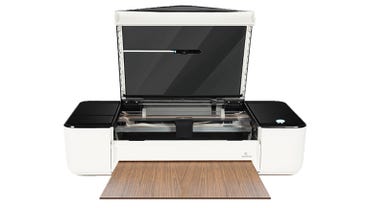Glowforge Pro review: Laser cutting and engraving for serious hobbyists and makers | ZDNet
The Glowforge Pro looks like a bulky large-format conventional printer, but rather than depositing ink on paper this 25kg (55lbs) device engraves and cuts a variety of materials.
Image: Charles McLellan / ZDNet
3D printing, and its industrial counterpart additive manufacturing, is widely covered on ZDNet and in the media generally. Prices range from a few hundred dollars to seven-figure sums, with materials including various kinds of plastic, resins, metals and even concrete.
Another kind of device, which also spans the range from hobbyist to industrial applications, is the CNC laser cutter/engraver, which can etch designs into a variety of materials, including plastic, leather, wood, metal and glass, and also cut out shapes from some of them, which you can then assemble into 3D objects. That’s why Glowforge calls its device a ‘3D laser printer’.
Founded in 2014, Glowforge raised a record $27.9 million for a 30-day crowdfunding campaign in October of the following year, and launched its finalised product range in April 2018. There are three models, with different combinations of laser power, performance and maximum ‘print’ size. Glowforge Basic costs $2,995, while the Plus model costs $3,995 and the Pro version costs $5,995. The company recently announced the availability of its product line in the UK (prices are a direct dollar-to-pound translation) — hence the presence of the Pro model on the reviews bench (OK, my home office) here at ZDNet UK.
Like
- Easy to set up and use
- Straightforward web-based software
- Handles a wide range of materials
- Active and useful community forums
Don’t Like
- Noise, odour
- Pro model is expensive
- Can’t engrave material over 5cm (2in.) thick
- Proofgrade materials are expensive
Design
The Glowforge Pro arrives in a bulky and well-protected box measuring 116.8cm by 71.1cm by 35.5cm (46in. x 28in. x 14in.) and weighing 32kg (70lbs). The device inside is 96.5cm wide by 52.7cm deep by 21cm tall (38in. x 20.75in. x 8.25in.) and weighs 25kg (55lbs) — a definite two-person lift. You’ll need a sturdy desk or table with at least 2.5cm (1in.) of clearance around all sides, and considerably more to the front and back if you intend to use the Pro’s passthrough slot to accommodate larger materials.
All three models can take materials measuring up to 20.4 inches wide by 18 inches deep by 2 inches thick, with a maximum printable area of around 11in. by 19.5in. The Pro’s passthrough slot allows for materials measuring 20 inches wide by a quarter of an inch thick, with no limit on length – you print 10 inches at a time and then slide the material through the slot to process the next section.
The Glowforge comes with an accessory pack that includes the black metal crumb tray, which sits in the bed of the printer to collect any debris, an exhaust hose that clamps over the outlet on the back of the device, and a starter pack of Proofgrade materials. We had a selection of woods and MDF, a couple of pieces of acrylic and some leather. Official Proofgrade materials come with peel-off protective coating on both sides and a QR code from which the Glowforge’s built-in camera reads the correct laser settings. If you buy third-party materials, you’ll need to check their CO2 laser compatibility, and ascertain the correct settings. The Glowforge Community is helpful with this issue, among numerous others.
There are two options for disposing of the dust and odour that emerge from the exhaust hose: you can route the hose to the outside through a window or a window vent, or you can attach it to the optional air filter unit. The latter is hefty both in terms of weight (22kg/48lbs) and expense ($995/£901.62), with replacement filter cartridges costing $250 or £187.96. The estimated cartridge lifetime depends on what you print, and for how long.
The Glowforge Pro looks like a big printer with a white moulded plastic case, a glass top and lid (with a camera on its underside), which opens to reveal the rail-mounted laser tube/arm/printer head mechanism, and the crumb tray on the floor of the device. There’s a front door that pulls down for easy access to the insides, with passthrough slots front and back for large materials (Pro model only). At the back you’ll find the power input, on/off switch and exhaust connection. There’s a large circular button on the top, on the right side towards the front, which flashes white to show that the Glowforge is ready to print, which it does when you press the button.
Setup & features
Once you’ve unboxed the Glowforge and put the various elements in place (printer head, crumb tray, exhaust hose) you power it up and wait for the button to glow a teal colour, which signifies that the printer’s temporary Wi-Fi access point is ready to connect to your computer (or phone) to complete the setup. You do this via setup.glowforge.com, signing in using the email and password used during the ordering process. Once the printer head has completed its calibration, you can reconnect to your usual Wi-Fi network. Wi-Fi is the only connection method between your computer and the Glowforge: there’s no cable involved, and an internet connection is required for print processing.
Projects are prepared for printing in the Glowforge web app, https://app.glowforge.com, which can import bitmap (JPG, PNG) and vector files (SVG, PDF). The app also provides access, via a Glowforge Premium subscription, to a catalogue of free and paid-for designs, and allows you to create your own projects from scratch using a variety of clip-art-style graphics, shapes and text in a range of fonts.
Glowforge Premium is, as the name suggests, not cheap: the full price is $/£50 a month, although it’s currently on offer at £349 in the UK when billed every 18 months (£19.39 a month). If you’re a confident user of vector graphics software like Inkscape or Adobe Illustrator, you may not need Glowforge Premium. But the tools (especially the auto-outline feature), artwork and fonts are useful, and the discount might well swing the decision for some users. Other Premium benefits include processing of print designs on faster cloud-based servers, unlimited cloud storage for your designs and early access to experimental features.
SEE: CES 2022 preview: Crowds set to return to Las Vegas, but digital element remains
You can also create a print by drawing or writing on paper, placing it in the bed of the device and having the camera in the lid turn it into a digital file, which you can then manipulate in various ways in the web app.
The Glowforge Pro uses a CO2 laser tube operating at 10,600nm and averaging 45W (the Plus and Basic models use less powerful 40W lasers), with the X/Y axis motors allowing the laser to engrave with 1,000dpi resolution. It can score (drawing a line, at low power) and engrave in multiple passes, varying the laser power between pixels to achieve different levels of darkness. The laser can also cut material up to half an inch (1.2cm) thick, at speeds depending on the material and its thickness.
You can’t cut metal, as this would require laser power levels beyond those feasible on a desktop device. However, you can cut wood, fabric, leather, paper, acrylic, mylar, rubber, and more. All of these materials can also be engraved, along with glass, coated metal, marble, anodised aluminium and titanium. So you can, if you wish, etch your name or a design onto your phone, tablet or laptop, among other things that aren’t more than two inches thick.
Usability & performance
I tested the Glowforge Pro by engraving photos and scans onto a variety of Proofgrade materials. I also created a headphone stand in MDF and etched the ZDNet logo into the back of an iPad.
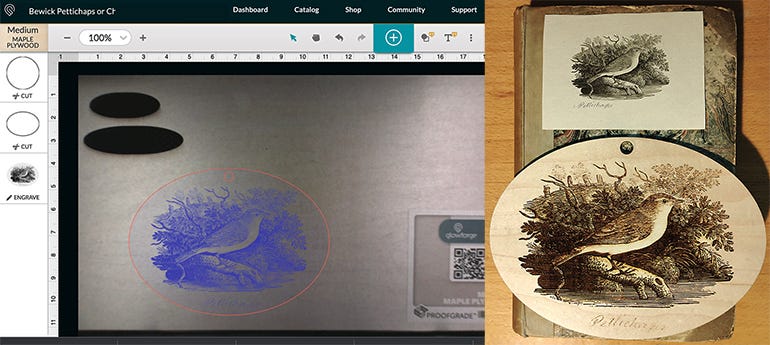
A scan of a wood engraving by Thomas Bewick (1753-1828), engraved onto Proofgrade maple plywood, which costs £20.26 in the UK per standard-size (12in. x 20in.) medium-thickness (1/8in.) sheet. Print time was around 40 minutes.
Image: Charles McLellan / ZDNet. Original artwork: Thomas Bewick
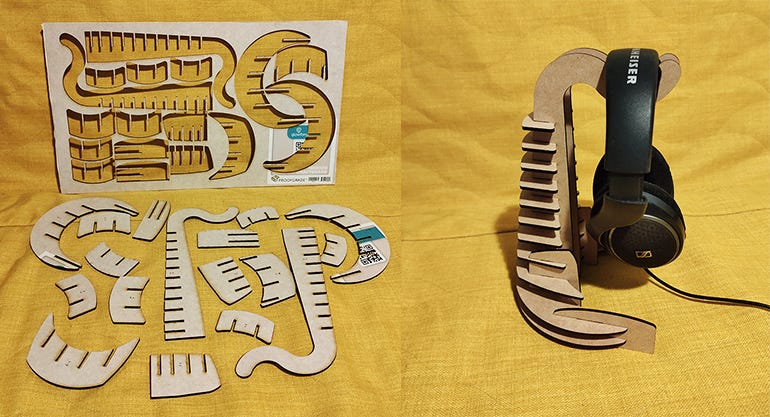
A headphone stand, cut and assembled from Proofgrade draftboard, which costs £8.28 in the UK per standard-size (12in. x 20in.) medium-thickness (1/8in.) sheet. The design was downloaded from the Glowforge Catalog, and print time was around 11 minutes.
Images: Charles McLellan / ZDNet
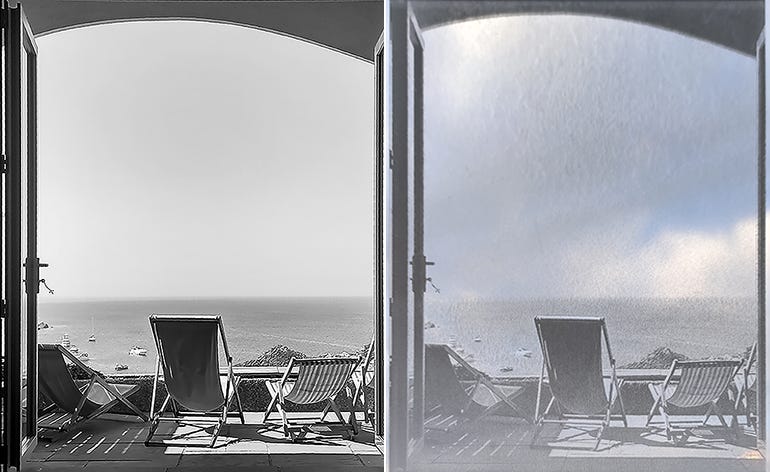
A photo (above left) engraved on Proofgrade clear acrylic at draft resolution and photographed against a window pane (above right). A standard-size (12in. x 20in.) medium-thickness (1/8in.) sheet of Proofgrade clear acrylic costs £16.96 in the UK.
Images: Charles McLellan / ZDNet
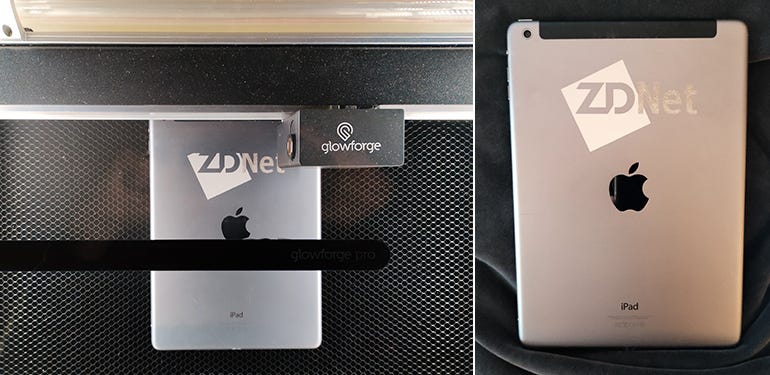
A logo etched onto the back of an iPad. I found the correct laser settings for this anodised aluminium material on the Glowforge forum. This etching took about 10 minutes.
Images: Charles McLellan / ZDNet
I had no major issues with any of these projects. The web app interface is straightforward, with good feedback about which stage of the process is underway. Print times will vary depending on the size and detail level of the content, whether it’s being engraved or cut, and the output resolution: photos can be Draft or HD; graphics can be Draft, SD or HD, and there’s a 3D Engrave option (for certain materials) that engraves with extra depth (you’ll need a heightmap image file for this). Removing the protective layer after printing can be fiddly for complex engravings, but it’s worth the effort: removing it prior to printing runs the risk of unsightly burn marks.
SEE: The secret to being more creative at work? Why timing could be the key
There’s a fair amount of noise when the Glowforge is operating, especially if you use the air filter as there will be two fans whirring away. The amount of noise and residual odour will depend on the content being printed and the material it’s being printed on. We tested the Glowforge in a home office in a small terraced house, but its preferred habitat is probably a spacious workshop where family/neighbour-annoyance won’t be an issue.
Conclusions
The top-end Glowforge Pro setup we tested, with the air filter unit, is by no means cheap at $6,990 or £6,897 all told ($/£5,995 + $995 or £902). Official Proofgrade materials carry premium prices, too, and certain types are currently in short supply in the UK. “Since launching Glowforge in the UK we have had a much higher demand than expected for Proofgrade materials. We are however doing our best to meet this demand and to ensure every UK customer receives their Proofgrade materials,” Glowforge told ZDNet.
More affordable third-party materials are available online and in retail outlets, but it’s up to you to determine their laser compatibility and apply the correct settings in the web app. Then there’s the Glowforge Premium subscription, if you need it, which is currently on offer at £19.39 a month.
If you’re prepared to vent the exhaust out of a window rather than use the air filter, drop down to a 40W laser with slower engraving and cutting speeds, and forego enhanced cooling and the passthrough slot, you can reduce the outlay to $/£3,995 for the Plus model — substantial savings of $2,995 and £2,902 over the Pro+air filter price tag. And if you don’t mind even slower engraving speed, and half the warranty period, $/£2,995 for the Basic model looks pretty attractive.
|
Glowforge model |
Pro |
Plus |
Basic |
|
CDRH classification |
Class 4 |
Class 1 |
Class 1 |
|
Laser power |
45W |
40W |
40W |
|
Warranty |
12 months |
12 months |
6 months |
|
Upgraded hardware (faster speed) |
yes |
yes |
no |
|
Engraving speed |
3x |
2x |
1x |
|
Cut speed |
1.2x |
1x |
1x |
|
Enhanced cooling |
yes |
no |
no |
|
Passthrough slot |
yes |
no |
no |
|
Price |
$5,995 |
$3,995 |
$2,995 |
I found the Glowforge Pro a rewarding device to use. It’s straightforward to set up, engraves and cuts a good range of materials, and use cases are limited more by the user’s creative capabilities than any deficiencies of the machine itself.
You’ll need to be aware of safety, especially if experimenting with third-party materials, and will have to cope with noise and some odour issues when printing – even if you have the exhaust hose properly set up. You’ll also need plenty of room to house this large device, especially if you intend to use the Pro’s passthrough slot.
You don’t have to spend $3-6,000 on a laser cutter/engraver, as (less capable) products are available for as little as $500, or even less. We’re looking here at the mid-range, while above Glowforge’s offerings are industrial-level devices that cost considerably more.
The Glowforge Pro is an excellent choice for well-heeled hobbyists and makers, while the Plus and Basic models offer more affordable routes into the world of laser cutting and engraving. Glowforge is not just for hobbyists, either: many users run profitable small businesses selling the projects they create on these versatile machines.
RECENT AND RELATED CONTENT
Desktop Fabrication 2022: Looking forward to a year of fun in the Fab Lab
Desktop Metal Q3 revenue light, aims to scale its 3D printing systems
3D printing vendors poised to benefit long term from supply chain disruptions
3D printing suppliers Ultimaker and Formlabs launch post-processing solutions
Stratasys expands 3D printed anatomical modeling efforts
Read more reviews
For all the latest Technology News Click Here
For the latest news and updates, follow us on Google News.

